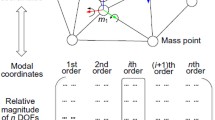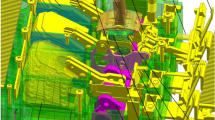Abstract
The present research on moulded case circuit breaker(MCCB) focuses on the enhancement of current-limiting interrupting performance during short circuit, overload, under voltage and phase failure, involving electrics, magnetic, mechanics, thermal, material, friction, arc extinguishing, impact vibration, skin effect, etc. The rigid-flexible coupling of the parts and components of the metamorphic manipulating mechanism in multi-fields leads to the non-rigid, high frequency, high damping, singularity of the Euler-Lagrange equations which represents the multi-body dynamics. The small step iteration which is used for obtaining the instantaneous and short time critical interrupting performance of metamorphic mechanism appears inaccuracy. It is difficult to realize top-down design by existing CAD systems. Therefore, a metamorphic manipulating mechanism design method for MCCB using index reduced iteration(IRI) is put forward. The metamorphic manipulating mechanism of MCCB is decomposed into three mechanisms: main switch connector mechanism, electromagnet-drawbar-jump buckle mechanism, and bimetallic strip-drawbar mechanism, which is respectively described by electro-dynamic force, electromagnet force, and bimetallic strip force. The dummy part(virtual rigid) without moment of inertia and mass is employed as intermediate to join the flexible body and rigid body. The model of rigid-flexible coupling metamorphic mechanism multi-body dynamics is built. The differential algebraic equations(DAEs) of the multibody dynamics model are converted to pure ordinary differential equations(ODEs) by coordinate partition. Order reduced integration with multi-step and variable step-size is preceded based on IRI. The non-linear algebraic equations are solved in each integration step by Newton-Rapson iteration. There is no ill-condition and singularity of Jacobian matrix when step size reduces to zero. The independent prototype design system using ACIS R13, HOOPS V11.0 and Visual C++.NET 2003 has been developed, which verifies the effectiveness of the proposed method. The proposed method enhances the current-limiting interrupting performance of MCCB, and has reference significance for multi-body dynamics design for similar flexible metamorphic mechanisms in multi-fields.
Similar content being viewed by others
References
LI Duanling, ZHANG Zhonghai, MCCARTHY J M. A constraint graph representation of metamorphic linkages[J]. Mechanism and Machine Theory, 2011, 46(2): 228–238.
WEI Guowu, DAI J S. Geometric and kinematic analysis of a seven-bar three-fixed-pivoted compound-joint mechanism[J]. Mechanism and Machine Theory, 2010, 45(2): 170–184.
MEIER S D, MOORE P J, COVENTRY P F. Radiometric timing of high-voltage circuit-breaker opening operations[J]. IEEE Transactions on Power Delivery, 2011, 26(3): 1 411–1 417.
PHILIPP S. A complete circuit breaker model for calculating very fast transient voltages[C/CD]//Conference Record of IEEE International Symposium on Electrical Insulation, San Diego, CA, United states, June 6–9, 2010.
GEORGE E, JOSEPH E. Performance of HRC fuse and MCCB in low voltage distribution network[C/CD]//IEEE/PES Power Systems Conference and Exposition, Phoenix, AZ, United states, March 20–23, 2011.
PARK S K, PARK K Y, CHOE H J. Flow field computation for the high voltage gas blast circuit breaker with the moving boundary[J]. Computer Physics Communications, 2007, 177(9): 729–737.
MATSUMURA T, HIRATA S, CALIXTE E, et al. Current interruption capability of H2-air hybrid model circuit breaker[J]. Vacuum, 2004, 73(3–4): 481–486.
ROODENBURG B, EVENBLIJ B H. Design of a fast linear drive for (hybrid) circuit breakers-Development and validation of a multi domain simulation environment[J]. Mechatronics, 2008, 18(3): 159–171.
LEE J C, KIM Y J. The influence of metal vapors resulting from electrode evaporation in a thermal puffer-type circuit breaker[J]. Vacuum, 2007, 81(7): 875–882.
DAI Jiansheng, DING Xilun, WANG Delun. Topological changes and the corresponding Matrix operations of a spatial metamorphic mechanism[J]. Chinese Journal of Mechanical Engineering, 2005, 41(8): 30–35.
ZHANG Shuyou, YI Guodong, XU Xiaofeng. Reverse design approach for mechanism trajectory based on code-chains matching[J]. Chinese Journal of Mechanical Engineering, 2007, 20(3): 86–90.
ZHANG Shuyou, YI Guodong, XU Xiaofeng. Modeling method for product structure mapping based on the reverse solving of trajectory and motion[J]. Chinese Journal of Mechanical Engineering, 2007, 20(5): 114–119.
CHEN Fuchen. Dynamic response of spring-type operating mechanism for 69 kV SF6 gas insulated circuit breaker[J]. Mechanism and Machine Theory, 2003, 38(2): 119–134.
PIQUERAS L, HENRY D, JEANDEL D, et al. Three-dimensional modeling of electric-arc development in a low-voltage circuit-breaker[J]. International Journal of Heat and Mass Transfer, 2008, 51(19–20): 4 973–4 984.
CABRERA J A, NADAL F. Multiobjective constrained optimal synthesis of planar mechanisms using a new evolutionary algorithm[J]. Mechanism and Machine Theory, 2007, 42(7): 791–806.
CABRERA J A, ORTIZ A, NADAL F, et al. An evolutionary algorithm for path synthesis of mechanisms[J]. Mechanism and Machine Theory, 2011, 46(2): 127–141.
GAN Dongming, DAI J S, LIAO Qizheng. Constraint analysis on mobility change of a novel metamorphic parallel mechanism[J]. Mechanism and Machine Theory, 2010, 45(12): 1 864–1 876.
CHEN Degui, LI Xingwen, DAI Ruicheng. Effect of different vent configurations on the interruption performance of arc chamber[J]. IEICE Transactions on Electronics, 2010, E93-C(9): 1 399–1 403.
NATTI S, KEZUNOVIC M. Assessing circuit breaker performance using condition-based data and Bayesian approach[J]. Electric Power Systems Research, 2011, 81(9): 1 796–1 804.
HUANG Jian, HU Xiaoguang, GENG Xin. An intelligent fault diagnosis method of high voltage circuit breaker based on improved EMD energy entropy and multi-class support vector machine[J]. Electric Power Systems Research, 2011, 81(2): 400–407.
BARTOSZ R, GERD B, MARTIN H, et al. Timings of high voltage circuit-breaker[J]. Electric Power Systems Research, 2008, 78(12): 2 011–2 016.
DRAGAN M, PREDRAG O, KOVILJKA S, et al. Dielectric characteristics of vacuum circuit breakers with CuCr and CuBi contacts before and after short-circuit breaking operations[J]. Vacuum, 2011, 86(2): 156–164.
LI Duanling, ZHANG Zhonghai, MCCARTHY J M. A constraint graph representation of metamorphic linkages[J]. Mechanism and Machine Theory, 2011, 46(2): 228–238.
XU Wenliang, ZHANG Shuyou, YI Guodong, et al. Motion constraint recognition and its application oriented to multibody simulation[J]. Chinese Journal of Mechanical Engineering, 2008, 44(6): 137–142. (in Chinese)
LIN Xiaoxia, ZHANG Shuyou, CHEN Jing, et al. Method for asymmetric distributed loads on curving areas in products simulation analysis[J]. Chinese Journal of Mechanical Engineering, 2010, 46(1): 122–127. (in Chinese)
ZHAO Zhen, ZHANG Shuyou. Method of step self-adaptive sequential-interaction and application in problem of transient fields coupling[J]. Computer Integrated Manufacturing System, 2011, 17(7): 1 404–1 414. (in Chinese)
XU Jinghua, ZHANG Shuyou, YI Guodong, et al. Object variation oriented kinematics optimization design for manipulator[J]. Journal of Zhejiang University (Engineering Science). 2011, 45(2): 209–216. (in Chinese)
Author information
Authors and Affiliations
Corresponding author
Additional information
This project is supported by National Basic Research Program of China (973 Program, Grant No. 2011CB706506), National S&T Great Special of China(Grant Nos. 2012ZX04010011, 2011ZX04014-131), National Science Foundation for Young Scholars of China(Grant No. 51005204), and Postdoctoral Fund of China(Grant No. 20100471000)
XU Jinghua, born in 1979, is currently an assistant researcher at Zhejiang University, China. He received his PhD degree from Zhejiang University, China, in 2009. His research interests include digital mockup(DMU)
ZHANG Shuyou, born in 1963, is currently a professor and a PhD supervisor at Zhejiang University, China. He received his PhD degree from Zhejiang University, China, in 1999. His research interests include computer graphics, CAD, virtual reality and manufacturing information
ZHAO Zhen, born in 1983, received his PhD degree from Zhejiang University, China, in 2012. His research interests include multi-body dynamics.
LIN Xiaoxia, born in 1982, received his PhD degree from Zhejiang University, China, in 2011. His research interests include CAE.
Rights and permissions
About this article
Cite this article
Xu, J., Zhang, S., Zhao, Z. et al. Metamorphic manipulating mechanism design for MCCB using index reduced iteration. Chin. J. Mech. Eng. 26, 232–241 (2013). https://doi.org/10.3901/CJME.2013.02.232
Received:
Revised:
Accepted:
Published:
Issue Date:
DOI: https://doi.org/10.3901/CJME.2013.02.232




